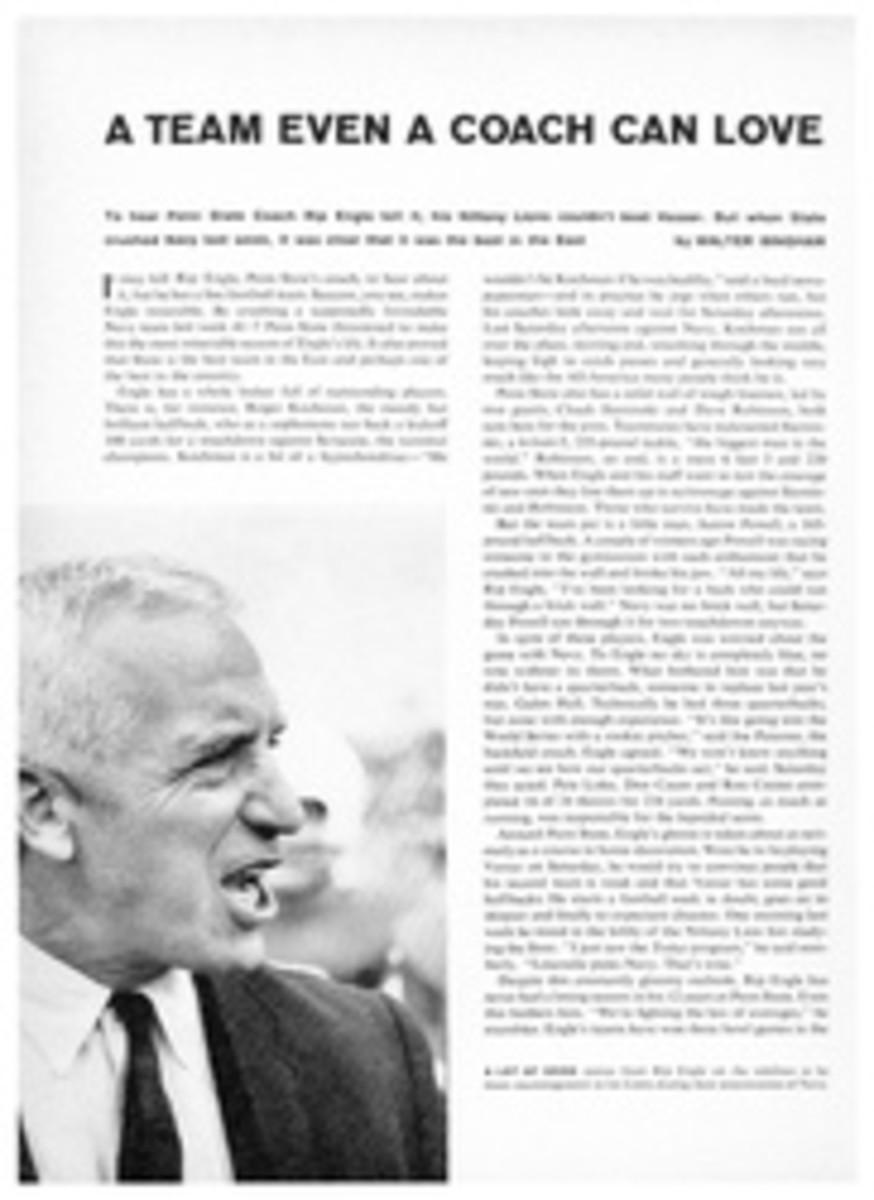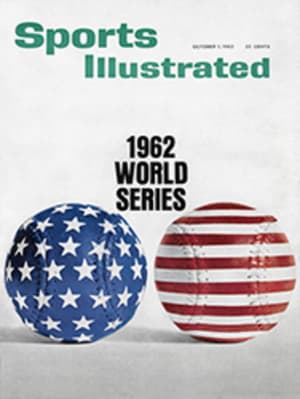
No rocking chair for Frank Gifford
"The New York Giants are an old football team if you measure age by years. If you measure age by the imponderables that separate champions from near champions in the National Football League, they are still relatively young. Allie Sherman, 39, the head coach of the Giants, is young by whatever system you care to measure age; when he took over the head coaching job for the Giants two years ago, his friends congratulated or commiserated with him.
"Some of them said, 'Gee, Allie, you got a real break. Now you can show what you can do,'" Sherman said the other day. "Some others said, 'It's a shame, Allie. You're taking over a club that's beginning to fall apart from old age.' "
Sherman, meticulous and analytical, debated with himself for a long time before accepting the head coaching job with the Giants. He knew better than most people that many of the Giants were, indeed, growing old. He solved his problem by taking the films of Giant games for the three previous years and studying them.
"I got a long-range look at the thinking of the other coaches in the league," he said. "They begin to establish patterns and change their blocking assignments, and you can pick that up over three years. And T could check what I thought was the real problem. The Giants were supposed to be growing old. I could evaluate the performance of the old players over a stretch of three years. I could see how much they had slipped, if they had slipped at all. I could decide which old players to keep and which old players had to be replaced. You can't replace players wholesale, you know. You have to do it gradually."
As a result of his careful analysis, Sherman, wisely enough, kept most of the old Giants. They are still playing on the team—the Robustellis, Griers, Giffords and Modzelewskis—and they still make the Giants one of the most respected teams in football.
Typical of these Giants is Frank Gifford, a 32-year-old halfback returning to football after a year's layoff occasioned by a crushing tackle by another of the old men of pro football: the Philadelphia Eagles' 37-year-old linebacker and center, Chuck Bednarik. Bednarik's violent, blind side tackle left Frank lying still and almost dead on the cold ground of Yankee Stadium.
Dr. Francis Sweeney, who has been the team doctor for the Giants almost since the inception of the club, gave Gifford the go-ahead. "He had a deep concussion," Dr. Sweeney says. "The brain is like a mass of jelly inside three coverings, all of this suspended in the skull like a player's head is suspended inside a helmet. There's the subdura, the dura and the meninges. A severe shock may start a hemorrhage which can seep down into the lower parts of the brain and affect motor areas and be very serious. This is what Frank had. But once that heals, it's completely healed and doesn't have a carryover effect."
Gifford, of course, qualifies as one of the "aging" Giants. This season he is playing a new position at flanker back and, so far, he is not playing it quite as well as he played his old position. He used to be the right halfback for the club, carrying the ball into the ruck of the defense, off tackle or over the center. Now he's stationed wide to the side, away from the traffic.
"I'm as fast as I ever was," he said the other day. "I've got better reflexes. But I'm playing a new position on the opposite side of the line from where I played before and it takes time to get used to it. Old habit holds me and running the opposite way to catch passes makes it uncomfortable, so I drop more than I used to. But I want to play as much as I ever did, and that is really the big thing."
Gifford returned to football because he wanted to play.
"I made a lot of money in the year I stayed out," he said. "I didn't stay out because of the head injury. I had personal reasons I don't want to go into. But I missed pro football. I don't know any kind of business you can go into where you can get as much excitement once a week as you can get playing pro ball. Nothing you can care about as much. If you are lucky enough to be able to do this for a living, I think you should do it as long as you can."
The desire is the limiting factor in the age of a player, according to Dr. Sweeney.
"Most players go over the hill all at once," he says. "One year they are great, the next year they are finished. Physically, there isn't much difference; mentally, there's a tremendous difference. They no longer really want to make the sacrifices a pro player has to make to keep going. Actually, as far as injuries are concerned, the old player recovers more quickly than a young one. The knee was not built to play football on and it gets hurt the most. But the first knee injury is the worst. After that, the old player, whose knee ligaments are stretched to begin with and can be stretched more without taking long to return to normal, recovers faster. A rookie with a hurt knee may be out for three weeks. Y. A. Tittle, with ligaments stretched against Cleveland last week, is playing against the Eagles this week."
Gifford says the same thing in different words.
"When it's a drag, quit," he says. "I remember a ballplayer I don't want to name, but he got mentally tired. He could do everything physically he could ever do. But he didn't want to spend the time and mental effort it takes to play this game. To study the halfbacks who will cover you, learn every play perfectly, key yourself up. That's tougher than the physical conditioning. That makes more guys quit than losing a step. You get smart, you can pick up the step by thinking. The time when you have lost too much physically to pick up mentally comes later in your career. The Nomellinis in the league are 38 and still great because they want to play hard."
Sam Huff, a young Giant and one of the most competent middle linebackers in pro football, has the best position on the field for evaluating how much age has withered the Giant defensive line, now considered the vulnerable part of the Giant defense.
"I've been playing behind these guys six years," says Huff, a notably frank man. "When I came up they did the same things they do now. They do them just as fast and just as good, and if they didn't my job would be twice as tough. So some sportswriter says they're getting old and everybody else picks it up and it's not true. Believe me. I know."
Young Giants
"Economics is part of it," says Sherman, softly. "A boy who plays well on the Giant club for several years is given the opportunity to make good money in the off season and eventually it is not worthwhile to him to take the Sunday beating for the money we can pay him. Physically, he's as strong as ever. Mentally, he has reservations. Why shouldn't he? Very likely he has a wife and children to think of. That's one of the many factors you must take into consideration in evaluating a ballplayer. It is not easy." Sherman's evaluation of the old Giants was rather conclusively validated in the first two games of this season. The Giants lost to the Cleveland Browns, but looked the equal of the Cleveland team in doing so.
Then, last week, in the most grueling possible test of a defensive team, they whipped the Philadelphia Eagles 29-13. In this game Sonny Jurgensen threw 57 passes. He completed 33 and the Eagles ran the ball less than a dozen times; this is the kind of a game that tries the souls and bodies of defensive linemen, since they must come in after the passer play after play. Physically, defending against the run requires much less effort.
But at the end of the game elderly Andy Robustelli, running as young as you could want, chased Jurgensen far back and dumped him for a key loss, then old Rosey Grier moved in and blocked a field-goal attempt, which aging Jim Patton picked out of the air, carried awhile, then lateraled to middle-aged Dick Lynch, who ran 60 yards to score.
And, of course, bald Y. A. Tittle engineered the Giant offense all the way. His ligaments certainly had snapped back into place. All in all, football youth had its day.
PHOTO

